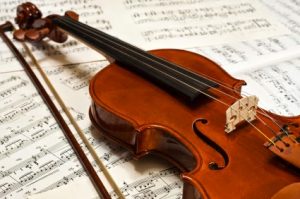Throughout history, violins have been utilized across countless nations  and cultures in virtually any genre of music. Though the most common of course fall within the categories of classical, jazz, and folk. Both of their physical attributes consisted of four to five steel core strings, a lengthy body that boasts an arched neck for cleaner, more concise notes, and both instruments were played with a bow. This is what has led so many people around the world to question, just what exactly is the difference between a violin and a fiddle; or more specifically, is there a difference?
and cultures in virtually any genre of music. Though the most common of course fall within the categories of classical, jazz, and folk. Both of their physical attributes consisted of four to five steel core strings, a lengthy body that boasts an arched neck for cleaner, more concise notes, and both instruments were played with a bow. This is what has led so many people around the world to question, just what exactly is the difference between a violin and a fiddle; or more specifically, is there a difference?
To start, fiddles are typically considered to be a more traditional version of a violin. Fiddles are mainly incorporated in Celtic, folk and bluegrass music, and performances. Fiddles appear to be strikingly similar to a violin, the appearance of its long shaped neck with slightly less of an arch, that is the key feature that distinguishes it from a violin. Additionally, a violin is comprised of four strings (G, D, A and E), while a fiddle boasts a fifth string (C).
 There are also variations in the tones of which are required for both fiddles and violins. For example, the fiddling style tends to use more string bending and multiple stops bowing; similar to that of a guitar. whereas the violin requires a significantly cleaner, single-note tone. The difference in these different tones of the instruments is often based on which techniques that the musician desires to utilize.
There are also variations in the tones of which are required for both fiddles and violins. For example, the fiddling style tends to use more string bending and multiple stops bowing; similar to that of a guitar. whereas the violin requires a significantly cleaner, single-note tone. The difference in these different tones of the instruments is often based on which techniques that the musician desires to utilize.
As time progressed, synthetic polymer strings were introduced for violins. The vast majority of musicians today overwhelmingly prefer these strings as they assist in the prevention of string corrosion, bendability, tuning solidity, and simply provide a warmer, more fresh sound for extended periods of time. To the contrary, fiddle strings are steel core and are low in cost while still creating clear accuracy and precision. Unfortunately, they are quite stiff and when pressure is applied, the strings have the tendency to cause the pitch to go much higher.
While most violinists are classically trained in their instrument, fiddle players are more likely to tend to improvise their own music. Which grants them the opportunity to exhibit their own natural musical talents and provide them with an increase in freedom throughout their performances. Both the violin and the fiddle styles and momentums can greatly vary depending namely on the genre of music that is being played and also the preference of the musicians themselves.
There is an age-old joke that boasts that the main difference between a fiddle and a violin, is that the fiddle is folksy and the violin is fancy. This may be true in a sense as the two are so incredibly closely related, but having seen the slight differences between them it can be said that they are certainly different instruments. One thing that can be agreed on is that both the fiddle and the violin are remarkable instruments that can literally take you away with just a simple pluck or glide of the bow.

